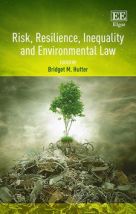Risk, Resilience, Inequality and Environmental Law

As we face pressing and difficult challenges generated from environmental changes, Risk, Resilience, Inequality and Environmental Law examines the ability of environmental law in the 21st century to manage transnational risks, and its compatibility with major environmental management strategies (page x). Principally, the book focuses on risk approaches and resilience approaches, the relationship between these, and how risk is being reframed. It frankly scrutinizes claims about resilience strategies that appear to be more democratic and egalitarian – and therefore potentially able to offer solutions to inequality – than risk approaches (page x). Whilst examining law as a governance device for environmental change, the book as a whole “aims to develop our theoretical understanding of risk, resilience, and inequality as it related to environmental regulation” (page 4).
In five sections, the book specifically investigates: A Changing Environmental Landscape (Part II); Inequality: The Social and Economic Consequences of Environmental Law (Part III); and Governance (Part IV). Part I and Part V introduce and conclude the book. The book’s 11 multidisciplinary chapters are united by a common theme of the relationship between law and risk & resilience approaches (pages xi and 25).
In Part I, editor Bridget Hutter outlines prominent environmental issues. Importantly, she includes in this a discussion of how we understand “environmental risks, uncertainties and damage, and the inequalities attaching to them”, as well as the strategies (namely, from risk and resilience approaches) to address these (page 4). Hutter also identifies that this is not only a highly political process, but significantly connected to economics (page 12).
Part II looks at the changing landscape in reference to environmental law. By doing so, it provides contrasting views of two legal systems (Australia and the UK) and “the potential of law to build resilience to climate change impacts and effect transformations in environmental control” (page 25).
Part III focuses on both the inequality and the socioeconomic consequences of environmental law. In light of climate change, it considers resilience and the generation of risk classes that further inequality. Based on a case study of Peru, it investigates the transformative power of biodiversity law. And, focusing on risk and resilience within urban populations in low- and middle-income nations, it emphasizes the importance of extending effective and affordable risk-reducing infrastructure and services to all.
Part IV then takes up issues of governance more directly. It considers new experiments in environmental governance, the role of insurance as a new governance structure, and the practice of risk and resilience strategies through law in China.
To conclude, Part V identifies main theoretical and analytical themes that run through all chapters. It considers a response to more pragmatic policy concerns and the applicability of experiments (identified in preceding chapters) to “different social and economic contexts of environmental regulation” (page 207). It concludes that law still has a significant role to play in managing environmental change. However, it is no longer “one of the most important regulatory regimes in modern societies” (page x). Instead it is “part of a broader governance framework where the law has the potential to facilitate some of the conditions that will make resilience strategies a reality” (page 226). Nevertheless, issues around implementation, enforcement and accountability remain pivotal to the effectiveness of the law in practice.
Book note prepared by Hannah Keren Lee
Search the Book notes database
Our Book notes database contains details and summaries of all the publications included in Book notes since 1993 - with details on how to obtain/download.
Use the search form above, or visit the Book notes landing page for more options and latest content.
For a searchable database for papers in Environment and Urbanization, go to http://eau.sagepub.com/

